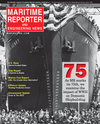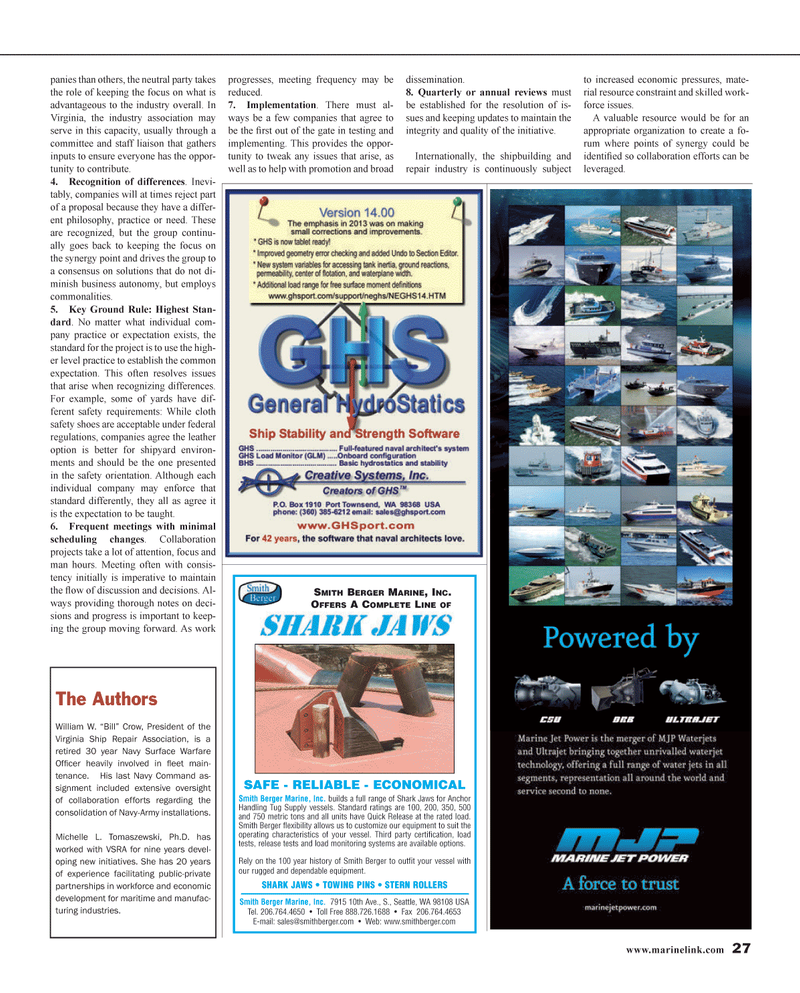
Page 27: of Maritime Reporter Magazine (January 2014)
Ship Repair & Conversion Edition
Read this page in Pdf, Flash or Html5 edition of January 2014 Maritime Reporter Magazine
www.marinelink.com 27 panies than others, the neutral party takes the role of keeping the focus on what is advantageous to the industry overall. In
Virginia, the industry association may serve in this capacity, usually through a committee and staff liaison that gathers inputs to ensure everyone has the oppor- tunity to contribute. 4. Recognition of differences. Inevi- tably, companies will at times reject part of a proposal because they have a differ- ent philosophy, practice or need. These are recognized, but the group continu- ally goes back to keeping the focus on the synergy point and drives the group to a consensus on solutions that do not di- minish business autonomy, but employs commonalities. 5. Key Ground Rule: Highest Stan- dard. No matter what individual com- pany practice or expectation exists, the standard for the project is to use the high- er level practice to establish the common expectation. This often resolves issues that arise when recognizing differences.
For example, some of yards have dif- ferent safety requirements: While cloth safety shoes are acceptable under federal regulations, companies agree the leather option is better for shipyard environ- ments and should be the one presented in the safety orientation. Although each individual company may enforce that standard differently, they all as agree it is the expectation to be taught. 6. Frequent meetings with minimal scheduling changes. Collaboration projects take a lot of attention, focus and man hours. Meeting often with consis- tency initially is imperative to maintain the fl ow of discussion and decisions. Al- ways providing thorough notes on deci- sions and progress is important to keep- ing the group moving forward. As work progresses, meeting frequency may be reduced. 7. Implementation. There must al- ways be a few companies that agree to be the fi rst out of the gate in testing and implementing. This provides the oppor- tunity to tweak any issues that arise, as well as to help with promotion and broad dissemination. 8. Quarterly or annual reviews must be established for the resolution of is- sues and keeping updates to maintain the integrity and quality of the initiative.
Internationally, the shipbuilding and repair industry is continuously subject to increased economic pressures, mate- rial resource constraint and skilled work- force issues.
A valuable resource would be for an appropriate organization to create a fo- rum where points of synergy could be identifi ed so collaboration efforts can be leveraged.
Smith Berger Marine, Inc. builds a full range of Shark Jaws for Anchor
Handling Tug Supply vessels. Standard ratings are 100, 200, 350, 500 and 750 metric tons and all units have Quick Release at the rated load.
Smith Berger flexibility allows us to customize our equipment to suit the operating characteristics of your vessel. Third party certification, load tests, release tests and load monitoring systems are available options.
Rely on the 100 year history of Smith Berger to outfit your vessel with our rugged and dependable equipment.
SMITH BERGER MARINE, INC.
OFFERS A COMPLETE LINE OF
SHARK JAWS • TOWING PINS • STERN ROLLERS
Smith Berger Marine, Inc. 7915 10th Ave., S., Seattle, WA 98108 USA
Tel. 206.764.4650 • Toll Free 888.726.1688 • Fax 206.764.4653
E-mail: [email protected] • Web: www.smithberger.com
SAFE - RELIABLE - ECONOMICAL
The Authors
William W. “Bill” Crow, President of the
Virginia Ship Repair Association, is a retired 30 year Navy Surface Warfare
Offi cer heavily involved in fl eet main- tenance. His last Navy Command as- signment included extensive oversight of collaboration efforts regarding the consolidation of Navy-Army installations.
Michelle L. Tomaszewski, Ph.D. has worked with VSRA for nine years devel- oping new initiatives. She has 20 years of experience facilitating public-private partnerships in workforce and economic development for maritime and manufac- turing industries.
MR #1 (26-31).indd 27 1/7/2014 10:39:31 AM

 26
26

 28
28
